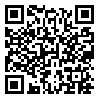Volume 16, Issue 2 (March & April 2025)
BCN 2025, 16(2): 393-402 |
Back to browse issues page
Download citation:
BibTeX | RIS | EndNote | Medlars | ProCite | Reference Manager | RefWorks
Send citation to:



BibTeX | RIS | EndNote | Medlars | ProCite | Reference Manager | RefWorks
Send citation to:
Zarei P, Raoufy M R, Shojaei A, Fathollahi Y, Mirnajafi-Zadeh J. Effect of High-frequency Electrical Stimulation of Olfactory Bulb on Spontaneous Excitatory Postsynaptic Currents in Hippocampal CA1 Pyramidal Cells of Kindling Rats. BCN 2025; 16 (2) :393-402
URL: http://bcn.iums.ac.ir/article-1-2930-en.html
URL: http://bcn.iums.ac.ir/article-1-2930-en.html
Parisa Zarei1 

 , Mohammad Reza Raoufy1
, Mohammad Reza Raoufy1 

 , Amir Shojaei1
, Amir Shojaei1 

 , Yaghoub Fathollahi1
, Yaghoub Fathollahi1 

 , Javad Mirnajafi-Zadeh *2
, Javad Mirnajafi-Zadeh *2 




 , Mohammad Reza Raoufy1
, Mohammad Reza Raoufy1 

 , Amir Shojaei1
, Amir Shojaei1 

 , Yaghoub Fathollahi1
, Yaghoub Fathollahi1 

 , Javad Mirnajafi-Zadeh *2
, Javad Mirnajafi-Zadeh *2 


1- Department of Physiology, Faculty of Medical Sciences, Tarbiat Modares University, Tehran, Iran.
2- Department of Physiology, Faculty of Medical Sciences, Tarbiat Modares University, Tehran, Iran. & Faculty of Medical Sciences, Institute for Brain and Cognition, Tarbiat Modares University, Tehran, Iran.
2- Department of Physiology, Faculty of Medical Sciences, Tarbiat Modares University, Tehran, Iran. & Faculty of Medical Sciences, Institute for Brain and Cognition, Tarbiat Modares University, Tehran, Iran.
Abstract:
Introduction: Deep brain stimulation (DBS) is a new therapeutic method for the treatment of neurological disorders such as epilepsy. However, the precise procedure underlying the anticonvulsant action of high-frequency stimulation (HFS) has remained unclear. This study explores the effect of HFS applied to the olfactory bulb (OB) on seizure-induced changes in spontaneous excitatory postsynaptic currents (sEPSCs) in kindling animals.
Methods: Male rats underwent a kindling procedure involving semi-rapid electrical stimulation (6 stimulations per day) of the hippocampal CA1 region. Fully kindled animals received HFS (at 130 Hz) at 5 min, 6 h, 24 h, and 30 h after the last kindling stimulation (kindled+HFS group). Subsequently, the impact of HFS on EPSCs was evaluated in CA1 pyramidal neurons of hippocampal slices from kindled subjects using the whole cell patch clamp technique.
Results: In kindling animals, sEPSC amplitude increased (P<0.001), while the sEPSC inter-event interval decreased compared to the control group (P<0.05). Applying HFS in the OB of fully kindled animals resulted in a reduction in sEPSCs amplitude and an increase in the inter-event interval of sEPSCs. No significant differences between kindling and control groups were observed in membrane potential and input resistance. Notably, the application of HFS in kindling animals restored the observed changes, so no significant difference was observed in the measured parameters between the kindled+HFS and control groups.
Conclusion: These findings suggest that the OB may be a viable target for DBS in epilepsy treatment. HFS application may mitigate a seizure-induced increase in sEPSCs occurrence.
Methods: Male rats underwent a kindling procedure involving semi-rapid electrical stimulation (6 stimulations per day) of the hippocampal CA1 region. Fully kindled animals received HFS (at 130 Hz) at 5 min, 6 h, 24 h, and 30 h after the last kindling stimulation (kindled+HFS group). Subsequently, the impact of HFS on EPSCs was evaluated in CA1 pyramidal neurons of hippocampal slices from kindled subjects using the whole cell patch clamp technique.
Results: In kindling animals, sEPSC amplitude increased (P<0.001), while the sEPSC inter-event interval decreased compared to the control group (P<0.05). Applying HFS in the OB of fully kindled animals resulted in a reduction in sEPSCs amplitude and an increase in the inter-event interval of sEPSCs. No significant differences between kindling and control groups were observed in membrane potential and input resistance. Notably, the application of HFS in kindling animals restored the observed changes, so no significant difference was observed in the measured parameters between the kindled+HFS and control groups.
Conclusion: These findings suggest that the OB may be a viable target for DBS in epilepsy treatment. HFS application may mitigate a seizure-induced increase in sEPSCs occurrence.
Type of Study: Original |
Subject:
Cellular and molecular Neuroscience
Received: 2024/05/7 | Accepted: 2024/07/28 | Published: 2025/03/1
Received: 2024/05/7 | Accepted: 2024/07/28 | Published: 2025/03/1
Send email to the article author
| Rights and permissions | |
 |
This work is licensed under a Creative Commons Attribution-NonCommercial 4.0 International License. |





